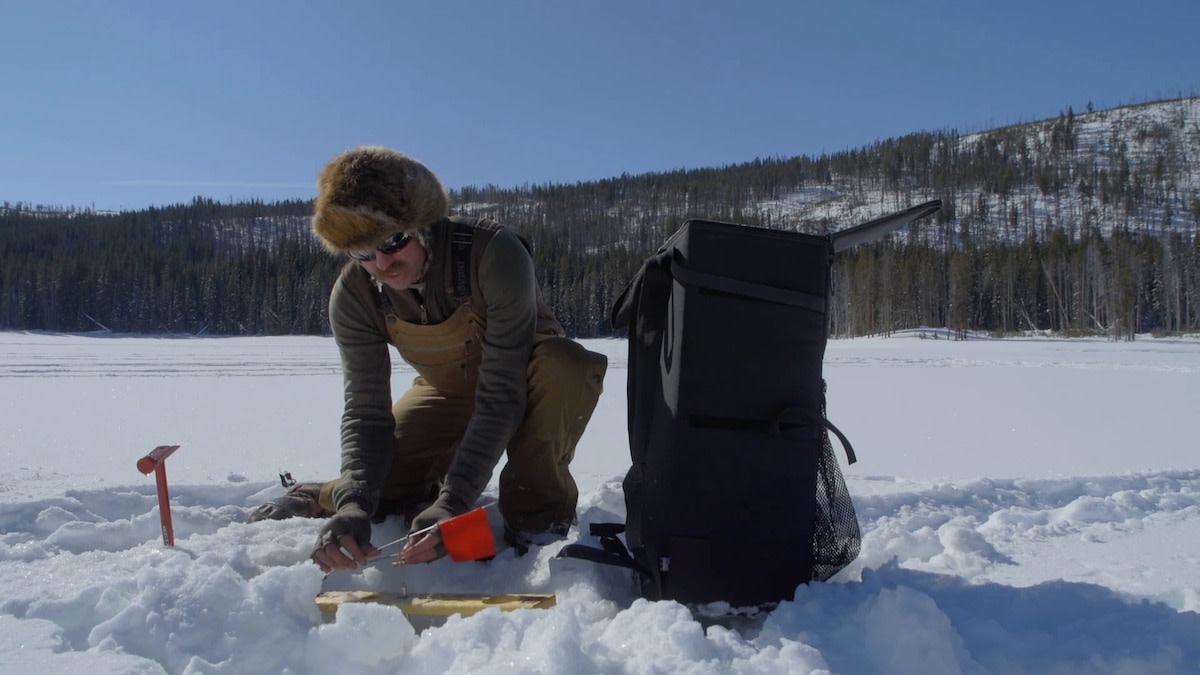
The Fur Hat Ice Tour How-To Series is brought to you by ESKIMO.
Few sights inspire more anticipation and urgency in anglers than a tripped tip-up flag. Hot pursuit by a bear might inspire more motivation, but not much else.
Tip-ups, also called ice traps, fish traps, or tilts, are mechanical strike indicators that allow fishermen to suspend bait under the ice without needing to be in constant contact with their line. They provide the ability to fish in several places at once for extended periods of time without actively managing lines—a huge boon for covering a lot of water. Used properly, these instruments are both practical and extremely effective.
Tip-ups come in many shapes and sizes, both commercially manufactured and homemade. In this video and article, we’ll deal with flat-board style tip-ups.
Before you set a tip-up, make a plan. If you know the depth or structure you want to cover, you can set your trapline at intervals along that contour. If you’re still trying to figure out where the fish are holding or traveling, you can set a variety of tip ups at different depths off a particular piece of structure, like a point, for example. Either way, it’s helpful to place your tip-ups in a roughly straight line so you can see them from a distance, check them easily, and maintain a trail in between.
Most anglers fill tip-up spools with heavy braided line or string, followed by a section of monofilament, fluorocarbon, or wire leader in the case of toothy fish like pike. Hook size and bait choice varies widely based on the species you’re pursuing.
Most tip-up fishing involves suspending live or dead bait just above the bottom. To find the right distance, you can use a clip-on bottom checker weight or just spool out your rig until it settles on the bottom, then reel it back up a few feet then run the line through the keeper. Bait resting on the bottom may get noticed by fewer fish. Many ice anglers will thread a button on their line to mark the bottom depth, allowing them to rebait and reset more quickly.
Once you’ve found your distance, bait your hook and place your tip-up over your hole with the board resting on top of the ice perpendicular to the spindle. The spool must be underwater so it doesn’t freeze. Most commercial tip-ups include a few different sensitivity settings for your flags. If it’s windy or you’ll be gone awhile, maybe set your flag on the deep-notch heavy setting. If you’re chasing smaller fish or watching closely, the hair-trigger shallow notch might be a better call.
Once your trapline is set, find a place to observe your flags while you hang out or jig. Most of the MeatEater crew carries our binoculars in a chest harness in order to keep an eye on flags. It also helps to clear an easy trail through the snow so you don’t hurt yourself sprinting to a popped trap. You may be laughing, but I’ve seen it. Ice fishing injuries are a thing.
Once the magic happens and you arrive at a tip-up with its flag flying, take a quick moment to see if the spool is spinning or the hole is frozen over. It often helps to give fish a moment to take the bait. When you’re ready to set the hook, gently lift the tip-up out of the hole, grab the line, and sweep firmly upward. Once you’re tight, recover the line hand over hand, piling it neatly in case the fish runs and you have to give slack. When the fish reaches the hole, you can either lift it clear or use a gaff on heavier specimens.
Tip-up fishing is among the most exciting and effective ways to spend a winter day. When that flag trips, you’ll find yourself running faster than you thought was possible without a bear on your heels.
Make sure to watch the latest episode of The Fur Hat Ice Tour as Ryan Callaghan and Miles Nolte go deep into the Montana backcountry in search of brook trout, burbot, and grayling.




